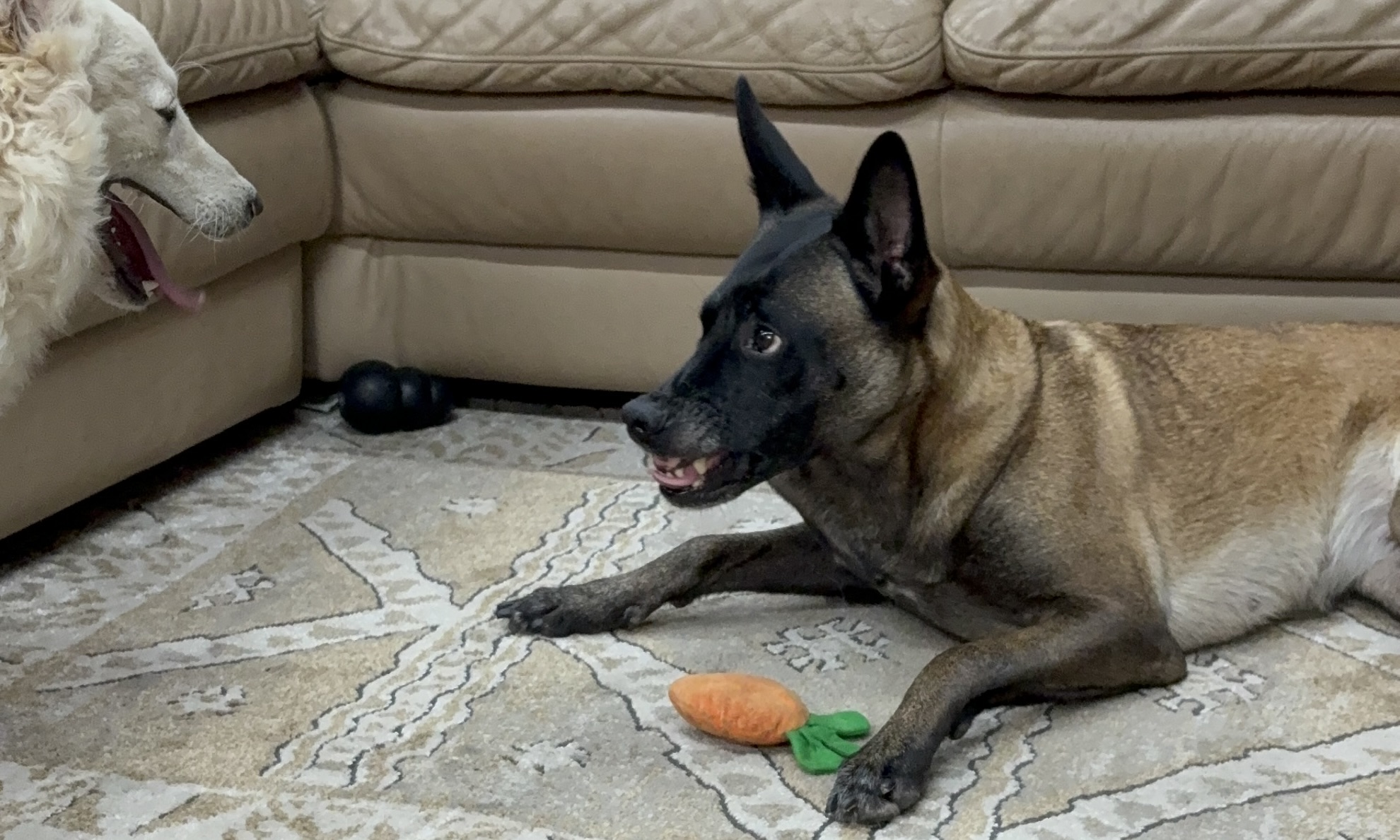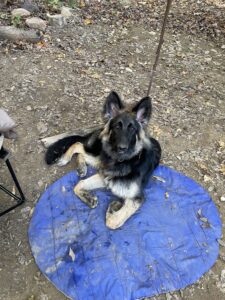Resource guarding comes in many shapes, sizes, and intensity levels. When we are looking at managing resource guarding, we are prioritizing avoiding the possessive or defensive feelings and behaviors associated.
Our dogs can’t tell us how they’re feeling using words, so pay close attention to body language.
Avoiding feelings of conflict doesn’t always require removal of these resources. Some resources will be impossible to remove, especially locations, people, and miscellaneous objects. In these cases, we instead want to be mindful when managing access and interaction.
A physical barrier is sometimes not enough to avoid guarding feelings. For some dogs, they need to be entirely unaware of a triggering event. In these cases, a closed door, white noise, or other distraction may be appropriate.
Here are some ways we might manage resource guarding during a training program:
- Giving consumable resources in a designated safe space – crate, play pen, special room, their bed, their tether station, etc.
- Not only does this help prevent people from unintentionally disturbing a dog enjoying a resource, but it also helps the dog learn that his safe zone is just that – safe! He doesn’t need to guard his stuff if the barrier keeps him safe.
- Storing guarded resources in an out-of-the-way location to avoid frequent proximity to contested resources.
- Using a baby gate or x-pen to block access to kitchen and dining area so accidentally dropped food is not a concern.
- Reducing or eliminating use of non-essential resources (toys, chews, special treats, food enrichment toys, etc)
- Using a baby gate or x-pen to block access to guarded people when they interact with other dogs / humans / etc.
- Proactively preventing access to guarded locations and furniture.
Using multiple layers of management may be appropriate for some dogs. This might look like using a leash and gate, muzzle and leash, crate and closed door, etc.
Inter-Dog Resource Guarding
Managing resource guarding between dogs can be a lot more challenging than managing it from people. People tend to be easier to instruct and direct (most of the time). When you are managing dog-dog resource guarding, you need to take the personalities of all dogs in the household into account, and their individual preferences and challenges.
Management of inter-dog resource guarding in a multi-dog household, or when other dogs visit, might look like:
- Using “safe zones” to grant access to resources – one safe zone per dog.
- Picking up all resources before letting dogs share space, including bowls when dogs are finished eating.
- Keeping dogs separated until all resource-adjacent objects are removed from the area.
- When one dog is receiving attention or another resource, they get to keep it. (Prevent other dogs from intruding.)
- Using designated crates and preventing dogs from entering other dogs’ crates.
- Keeping crate doors closed can help dogs feel safe about the resources they recieve in there.
- Using crate covers and “airlocks” – ie x-pens around crates to create a buffer zone.
- Giving all dogs ample individual / solo time with valued resources.
Identifying Sensitive Resources
Dogs can guard a variety of things, and if your dog is guarding one thing – there’s a decent chance they’re guarding other things as well, just with more subtlety. If you’re trying to identify what your dog might be guarding, look for conflicted behavior that occurs in proximity to resources, or seemingly “out of nowhere”.
Remember: humans and dogs have different value systems. It wouldn’t occur to me to guard a pine cone – it’s just a pine cone! There are plenty of them around! But that doesn’t mean your dog hasn’t assigned a high value to that particular pine cone. One of our dogs loves sticks and tree branches, and will guard them from our other dogs. We have many many trees on our property, and many many branches. But that one is hers. So is that one. So is that one. And so forth…
This is a long, but not exhaustive, list of objects I have seen dogs guard:
- Food & consumables
- Empty & full food bowls
- Special treats or food toppers
- Consumable chews (bully sticks, tendons, etc)
- Training treats
- Filled and empty food stuffed toys (Kong, Toppl, etc)
- Dropped or scattered food
- Water
- Regular water dish (empty or full)
- Water sources in nature (on hikes)
- Ice cubes
- Toys & play objects
- Chew toys
- Interactive toys
- Plush toys
- Squeaky toys
- People
- Family members
- New friends
- Children
- Trainers
- Affection, attention, or interaction time
- Limbs (feet, hands, etc)
- Locations
- Dog beds
- Furniture
- Crates
- Mealtime locations
- Training equipment and props
- Places where food scatters have happened in the past
- Places where a treat or target odor has been hidden for scent work
- Toy box
- Food and treat storage
- Kitchen
- Pantry
- Car
- Leash hanging area
- Doors and gates
- Miscellaneous objects
- Dirty laundry
- Sticks, branches, acorns, pinecones, and rocks
- Pieces of lumber scrap
- A specific brick
- Stolen objects (TV remote, shoes, etc)
- Paper towels, kleenexes
- Trash can & garbage
- Their leash, muzzle, or other training equipment
- Pillows, blankets, other bedding



